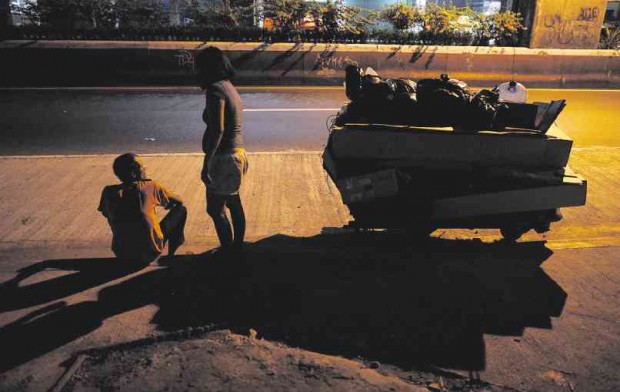
A MAN talks to his wife beside their “home”—a wooden cart filled with recyclable materials—in Manila where the city government has set a target of clearing the streets of homeless people by the end of the month. AFP
Clearing the city’s streets is now a 24/7 job for Manila’s Department of Social Welfare (MDSW), its officer in charge Dr. Arnold Pangan said on Tuesday.
Starting this week, Pangan said he and the MDSW staff involved in clearing operations would work in shifts every day to achieve the city’s target of “zero street dwellers” by the end of the month.
“In effect, we will be resting [only] from 3 a.m. to 6 a.m. [every day],” said Pangan. “We are already rushing operations and so far, have cleared 60 percent of Manila’s streets. I think we will meet the end-of-the-month deadline.”
The MDSW’s round-the-clock operations kicked off at 9 p.m. on Monday along the stretch between the United States Embassy and the Ospital ng Maynila on Roxas Boulevard. By 2 a.m., Pangan said they were able to take in 46 individuals.
Show of resistance
Some tried to resist but Pangan said this was common behavior among vagrants being taken off the streets.
“We’re used to resistance, especially when there are members of the media covering our operations, because these people are used to living on the street. We always have policemen assisting us. In the end, however, they still come with us peacefully,” he added.
In an earlier interview, Pangan said that the rescued street dwellers in Manila would first be taken to the city’s Reception and Action Center (RAC) to be fed, cleaned and interviewed before being transported to the Manila Boystown Complex in Marikina City.
They will remain at the facility temporarily until the RAC’s renovation is completed.
No more escapees
According to Pangan, the MDSW was still waiting for a go-signal from the Department of Social Welfare and Development to start the renovation of the homeless shelter since funding would come from the national agency.
On Tuesday, Pangan said escaping vagrants were no longer a problem at the Boystown complex since the people who had been helping others leave the facility in exchange for money were captured recently.
“Two men were pinpointed by our witness who had escaped before with their help,” he told the Inquirer. “[The] Boystown staff have reported them to [the] Marikina police.”
Around 1,200 individuals are now living at Boystown, 75 percent of whom are from Manila while the rest are from neighboring local government units, said Pangan.

